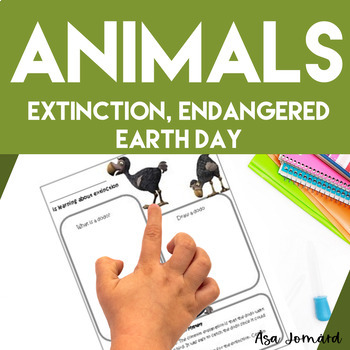Animals Extinction Activities | Endangered | Alice & the Dodo Race | Nonfiction
- PDF
- Easel Activity
Also included in
- Looking for exciting science resources that students will appreciate and enjoy using? Spark an interest in nature and wildlife as well as the environment with the engaging resources in this bundle. You'll save time planning your science activities using this Bundle. With many interesting facts and cPrice $45.00Original Price $60.05Save $15.05
- This is a Science Bundle with both printable and digital formats. It includes everything you will need to have excellent and varied science and art activities available for your students. The aim is to ignite a love for question-asking and using biomimicry challenges in the classroom. Design inspirePrice $90.00Original Price $138.20Save $48.20
- Looking for exciting science resources that students will appreciate and enjoy using? Spark an interest in nature and wildlife as well as the environment with resources in this bundle.You'll save time by purchasing this easy to use introduction to environmental issues. What are you waiting for?Price $16.50Original Price $24.70Save $8.20
Description
Explore Earth Day and Extinction by jumping into the world of literacy! The dodo is a fascinating creature and a perfect way to inspire and engage students to explore extinction and endangered animals. This unique resource is a perfect way to use the books about Alice to add an environmental twist.
This resource has been prepared so that your students can use it on digital devices. I have selected suitable slides for you, you need to insert text boxes and you can also add instructions for your students.
Contact me at maliasa@live.com if you have any questions, thanks.
Please click the PREVIEW button above to get a better idea of everything included.
This engaging Animal package contains:
1. What is a dodo?
2. I love dodos because. . .
3. What does extinct mean?
4. The Cheshire cat had a vanishing smile - venn diagram
5. Why do animals become extinct
6. A race against time
7. The Hatter's Mad Idea - look for solution
8. Alice’s Animals Are they safe?
9. What if scientists could bring back the dodo?
10. Bring Back the Dodo
11. Extra , Extra , read all about it!
12. Writing papers, 1x lined 1x unlined
You may like Endangered Animals Research | PBL Unit Biomimicry Design Inspired by Nature
Environment Bundle | Project Based Learning NGSS
Leaving feedback when you purchase a resource earns you points toward FREE TPT purchases. I love that feedback!
Also, Follow Me and be notified when new products are uploaded. New products are always 50% off for the first 72 hours they are posted.
Reviews of other Think Dive - Sparking Children's Thinkibility products:
Project based learning: Bats, STEAM, Biomimicry
"This product is absolutely the favorite one I have purchased all fall! I love the information that is provided about bats - just enough to intrigue and encourage higher level thinking. There are graphic organizers, worksheets, and subtle suggestions to help young learners perform at their best! And best of all, it stretches their creativity! Thanks for such an amazing resource!"
Project based learning: Mammals, Reptiles & Amphibians - STEAM, Biomimicry, NGSS
"Used this for a Kindergarten STEAM club unit and it was a hit!"
Why am I qualified to write these environment and biomimicry resources? In 2015, I completed a course in Making Sense of Climate Change Denial at the University of Queensland. I was a member of BEN - Biomimicry Education Network - and a curator of educational resources at BEN. I am the author of the book Biomimicry with Theo & Tuva: Nature spotting inspires wild ideas. In 2015, I completed a course in Biomimicry: A Sustainable Design Methodology at Minneapolis College of Art and Design. I took part in the Biomimicry Design Challenge in 2021.
#writingpapers #creativethinking #aliceinwonderland #dodo #extinct #sparkingchildrensthinkibility #thinkdive #asajomard #tpt #digitalactivities









